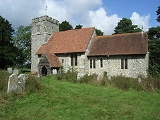
St Giles, Wormshill
Encyclopedia
St. Giles Church is the sole church in the village
of Wormshill
in Kent
. The church is Anglican
and is dedicated to Saint Giles
. It forms part of the united benefice
of Bredgar
, Milstead
, Bicknor
and Frinsted
. The ecclesiastical parish of Wormshill is in the Diocese of Canterbury
and the Sittingbourne deanery
(within the archdeaconry of Maidstone).
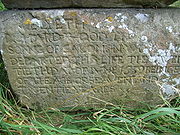 There has been a church in the village since around the time of the Norman Conquest although it was not specifically noted in the Domesday Book
There has been a church in the village since around the time of the Norman Conquest although it was not specifically noted in the Domesday Book
of 1086. The village itself has pagan roots as indicated by the toponomy of the name Wormshill (from the Anglo-Saxon
god Wōden
) however the church appears to have been built, at least in part, by Normans
since it displays Norman architectural features.
In 1995, the church received a new ring of six bells after a campaign by villagers begun in 1944 by Michael Nightingale of Cromarty
who, aged 16, opened a savings account with ten shilling
s for the restoration of the church's bells. Fifty years later he completed the full peal of six bells - one of which was original and five were rescued from abandoned churches. The church also contains a 13th century chest
, first discovered in the early 20th century. The church register dates back to 1700.
In January 2007, the interior of the church, exterior shots of the building and the churchyard
and surroundings were used extensively as locations in the filming of an episode of EastEnders
broadcast in the United Kingdom over the Easter 2007 holiday season. Mock gravestones together with a temporary Victorian
-style street lamp were added to the churchyard by the production crew.
In September 2010, a reward of £500 was offered for the return of a heavy brass altar cross and two brass candlesticks, which had been kept in the church for at least 150 years and were apparently stolen between 12 and 19 September 2010.
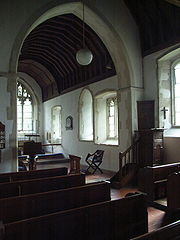
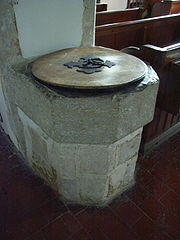 Officially recorded as being medieval in origin, parts of the church date back to the Norman era. Major renovation
Officially recorded as being medieval in origin, parts of the church date back to the Norman era. Major renovation
s of the church were in 1789 at a cost of £1,200, in 1879 (see below) and again early in the 20th century (1901). The building is constructed from flint
in the Early English style
.
In 1798, Edward Hasted
described the church as:
were an ancient landholding family in the area for at least three centuries and William Tylden's memorial stone lies set in the floor of the north chancel, showing his date of death as 23 December 1613.
Samuel Lewis, in his 1831 Topographical Dictionary of England wrote of a "tower steeple and some fine remains of stained glass in the great east window."
In 1852, Arthur Hussey described the church as having architectural features "certainly of a very early character" and further:
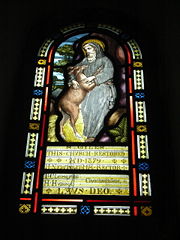 In 1851 the church was said to have seating capacity of "140" with "afternoon attendance: 82" and, in 1879, architect Joseph Clarke
In 1851 the church was said to have seating capacity of "140" with "afternoon attendance: 82" and, in 1879, architect Joseph Clarke
undertook further restoration
work. This work was commemorated by the addition of a new stained glass window (see image right) dedicated to Saint Giles
which bears the date of the restoration (1879) as well as the name of the vicar, "H. Newport" and church wardens Tom Clements (who was at one time the village postmaster) and "H. Hudson".
As of late 2007, structurally the church is unchanged in at least 200 years, as indicated by a watercolour painted in 1807, and still retains most of its earlier features. However the church has undergone a number of repairs and restorations, particular in respect to the building's roof, and the rebuilding of the tower and porch in 1903. An Edwardian
postcard (as compared with contemporary images) similarly indicates the interior remains relatively untouched.
The font
within the church is from the Norman era and the pulpit
is from Tudor
period. A stained glass
window dated 1879 in a small opening in the south wall depicts St Giles
, holding a stricken deer
, in keeping with the saint's story. Further stained glass includes the Northwood coat of arms
, dedicated to a former landholding family in the parish.
is the Reverend John Smith. A vicar
at the Rectory of Wormshill in the 19th century, Reverend Josiah Disturnell, was the subject of a debate as to early examples of exceptional "human longevity
" when he was cited as being 107 years old when he died. References to the rector's memorial stone in the church were ultimately provided as evidence of his actual age of death, being either "91 or 93".
The former rectory house (or vicarage) is now a private dwelling
.
Village
A village is a clustered human settlement or community, larger than a hamlet with the population ranging from a few hundred to a few thousand , Though often located in rural areas, the term urban village is also applied to certain urban neighbourhoods, such as the West Village in Manhattan, New...
of Wormshill
Wormshill
Wormshill , historically called Wormsell, is a small village and civil parish within the Borough of Maidstone, Kent, England. The parish is approximately south of The Swale and north of Maidstone. The villages of Frinsted and Bicknor are equidistant to the east and west, respectively; while...
in Kent
Kent
Kent is a county in southeast England, and is one of the home counties. It borders East Sussex, Surrey and Greater London and has a defined boundary with Essex in the middle of the Thames Estuary. The ceremonial county boundaries of Kent include the shire county of Kent and the unitary borough of...
. The church is Anglican
Anglicanism
Anglicanism is a tradition within Christianity comprising churches with historical connections to the Church of England or similar beliefs, worship and church structures. The word Anglican originates in ecclesia anglicana, a medieval Latin phrase dating to at least 1246 that means the English...
and is dedicated to Saint Giles
Saint Giles
Saint Giles was a Greek Christian hermit saint from Athens, whose legend is centered in Provence and Septimania. The tomb in the abbey Giles was said to have founded, in St-Gilles-du-Gard, became a place of pilgrimage and a stop on the road that led from Arles to Santiago de Compostela, the...
. It forms part of the united benefice
Benefice
A benefice is a reward received in exchange for services rendered and as a retainer for future services. The term is now almost obsolete.-Church of England:...
of Bredgar
Bredgar
Bredgar is a village and civil parish in the Borough of Swale in Kent, England. The village lies some 4 miles to the southwest of Sittingbourne on the road between Tunstall and Hollingbourne...
, Milstead
Milstead
Milstead is a village in the borough of Swale in Kent, England....
, Bicknor
Bicknor
Bicknor is a village and civil parish in the Maidstone district of Kent, England, north-east of Maidstone and south-west of Sittingbourne. It had a population of 68 according to the 2001 census....
and Frinsted
Frinsted
Frinsted or Frinstead is a small village in the parish of Wormshill and in the Maidstone District of Kent, England. and has been a recorded settlement as far back as the Domesday Book and indeed was the only settlement in the surrounding area to be described at the time to have a church...
. The ecclesiastical parish of Wormshill is in the Diocese of Canterbury
Diocese of Canterbury
The Diocese of Canterbury is a Church of England diocese covering eastern Kent, founded by St. Augustine of Canterbury in 597. It is centred on Canterbury Cathedral, and is the oldest see of the Church of England....
and the Sittingbourne deanery
Deanery
A Deanery is an ecclesiastical entity in both the Roman Catholic Church and the Church of England. A deanery is either the jurisdiction or residence of a Dean.- Catholic usage :...
(within the archdeaconry of Maidstone).
History

Domesday Book
Domesday Book , now held at The National Archives, Kew, Richmond upon Thames in South West London, is the record of the great survey of much of England and parts of Wales completed in 1086...
of 1086. The village itself has pagan roots as indicated by the toponomy of the name Wormshill (from the Anglo-Saxon
Anglo-Saxon
Anglo-Saxon may refer to:* Anglo-Saxons, a group that invaded Britain** Old English, their language** Anglo-Saxon England, their history, one of various ships* White Anglo-Saxon Protestant, an ethnicity* Anglo-Saxon economy, modern macroeconomic term...
god Wōden
Woden
Woden or Wodan is a major deity of Anglo-Saxon and Continental Germanic polytheism. Together with his Norse counterpart Odin, Woden represents a development of the Proto-Germanic god *Wōdanaz....
) however the church appears to have been built, at least in part, by Normans
Normans
The Normans were the people who gave their name to Normandy, a region in northern France. They were descended from Norse Viking conquerors of the territory and the native population of Frankish and Gallo-Roman stock...
since it displays Norman architectural features.
In 1995, the church received a new ring of six bells after a campaign by villagers begun in 1944 by Michael Nightingale of Cromarty
Cromarty
The Royal Burgh of Cromarty is a burgh in Ross and Cromarty, Highland, Scotland.-History:It was previously the county town of the former county of Cromartyshire...
who, aged 16, opened a savings account with ten shilling
Shilling
The shilling is a unit of currency used in some current and former British Commonwealth countries. The word shilling comes from scilling, an accounting term that dates back to Anglo-Saxon times where it was deemed to be the value of a cow in Kent or a sheep elsewhere. The word is thought to derive...
s for the restoration of the church's bells. Fifty years later he completed the full peal of six bells - one of which was original and five were rescued from abandoned churches. The church also contains a 13th century chest
Chest (furniture)
A chest is one of the oldest forms of furniture. It is typically a rectangular structure with four walls and a liftable lid, for storage. The interior space may be subdivided...
, first discovered in the early 20th century. The church register dates back to 1700.
In January 2007, the interior of the church, exterior shots of the building and the churchyard
Churchyard
A churchyard is a patch of land adjoining or surrounding a church which is usually owned by the relevant church or local parish itself. In the Scots language or Northern English language this can also be known as a kirkyard or kirkyaird....
and surroundings were used extensively as locations in the filming of an episode of EastEnders
EastEnders
EastEnders is a British television soap opera, first broadcast in the United Kingdom on BBC One on 19 February 1985 and continuing to today. EastEnders storylines examine the domestic and professional lives of the people who live and work in the fictional London Borough of Walford in the East End...
broadcast in the United Kingdom over the Easter 2007 holiday season. Mock gravestones together with a temporary Victorian
Victorian architecture
The term Victorian architecture refers collectively to several architectural styles employed predominantly during the middle and late 19th century. The period that it indicates may slightly overlap the actual reign, 20 June 1837 – 22 January 1901, of Queen Victoria. This represents the British and...
-style street lamp were added to the churchyard by the production crew.
In September 2010, a reward of £500 was offered for the return of a heavy brass altar cross and two brass candlesticks, which had been kept in the church for at least 150 years and were apparently stolen between 12 and 19 September 2010.
Architecture


Renovation
Renovation is the process of improving a structure. Two prominent types of renovations are commercial and residential.-Process:The process of a renovation, however complex, can usually be broken down into several processes...
s of the church were in 1789 at a cost of £1,200, in 1879 (see below) and again early in the 20th century (1901). The building is constructed from flint
Flint
Flint is a hard, sedimentary cryptocrystalline form of the mineral quartz, categorized as a variety of chert. It occurs chiefly as nodules and masses in sedimentary rocks, such as chalks and limestones. Inside the nodule, flint is usually dark grey, black, green, white, or brown in colour, and...
in the Early English style
English Gothic architecture
English Gothic is the name of the architectural style that flourished in England from about 1180 until about 1520.-Introduction:As with the Gothic architecture of other parts of Europe, English Gothic is defined by its pointed arches, vaulted roofs, buttresses, large windows, and spires...
.
In 1798, Edward Hasted
Edward Hasted
Edward Hasted was the author of a major county history, The History and Topographical Survey of the County of Kent .-Life:...
described the church as:
"dedicated to St. Giles, and consists of two isles and two chancelThe TyldensChancelIn church architecture, the chancel is the space around the altar in the sanctuary at the liturgical east end of a traditional Christian church building...
s, having a tower steepleSteeple (architecture)A steeple, in architecture, is a tall tower on a building, often topped by a spire. Steeples are very common on Christian churches and cathedrals and the use of the term generally connotes a religious structure...
at the west end of it. There are remains of good painted glass in the great east window. Several of the family of Tylden lie buried in it...In the church yard are some tombs of the Thatcher's, and for the Woods who resided at Northwood, in this parish and Bicknor."
Tylden (family)
The Tylden family represent a landholding family with origins in England in the Middle Ages. A branch of the family emigrated to the American colonies in the early 17th century and established the Tilden family line in America.-History:...
were an ancient landholding family in the area for at least three centuries and William Tylden's memorial stone lies set in the floor of the north chancel, showing his date of death as 23 December 1613.
Samuel Lewis, in his 1831 Topographical Dictionary of England wrote of a "tower steeple and some fine remains of stained glass in the great east window."
In 1852, Arthur Hussey described the church as having architectural features "certainly of a very early character" and further:
"In Wormshill church the arches, which are pointed, appear to be mere perforations of the wall, the soffitSoffitSoffit , in architecture, describes the underside of any construction element...
s being single, the angles not chamferChamferA chamfer is a beveled edge connecting two surfaces. If the surfaces are at right angles, the chamfer will typically be symmetrical at 45 degrees. A fillet is the rounding off of an interior corner. A rounding of an exterior corner is called a "round" or a "radius"."Chamfer" is a term commonly...
ed, of the thickness of the wall, flat and plain from one side to the other."

Joseph Clarke (architect)
Joseph Clarke, FRIBA was a British Gothic Revival architect who practised in London, England.-Career:In 1839 Clarke exhibited an antiquarian drawing with the Oxford Society for Promoting the Study of Gothic Architecture. Clarke was made an Associate of the Royal Institute of British Architects in...
undertook further restoration
Victorian restoration
Victorian restoration is the term commonly used to refer to the widespread and extensive refurbishment and rebuilding of Church of England churches and cathedrals that took place in England and Wales during the 19th-century reign of Queen Victoria...
work. This work was commemorated by the addition of a new stained glass window (see image right) dedicated to Saint Giles
Saint Giles
Saint Giles was a Greek Christian hermit saint from Athens, whose legend is centered in Provence and Septimania. The tomb in the abbey Giles was said to have founded, in St-Gilles-du-Gard, became a place of pilgrimage and a stop on the road that led from Arles to Santiago de Compostela, the...
which bears the date of the restoration (1879) as well as the name of the vicar, "H. Newport" and church wardens Tom Clements (who was at one time the village postmaster) and "H. Hudson".
As of late 2007, structurally the church is unchanged in at least 200 years, as indicated by a watercolour painted in 1807, and still retains most of its earlier features. However the church has undergone a number of repairs and restorations, particular in respect to the building's roof, and the rebuilding of the tower and porch in 1903. An Edwardian
Edwardian period
The Edwardian era or Edwardian period in the United Kingdom is the period covering the reign of King Edward VII, 1901 to 1910.The death of Queen Victoria in January 1901 and the succession of her son Edward marked the end of the Victorian era...
postcard (as compared with contemporary images) similarly indicates the interior remains relatively untouched.
The font
Baptismal font
A baptismal font is an article of church furniture or a fixture used for the baptism of children and adults.-Aspersion and affusion fonts:...
within the church is from the Norman era and the pulpit
Pulpit
Pulpit is a speakers' stand in a church. In many Christian churches, there are two speakers' stands at the front of the church. Typically, the one on the left is called the pulpit...
is from Tudor
Tudor style architecture
The Tudor architectural style is the final development of medieval architecture during the Tudor period and even beyond, for conservative college patrons...
period. A stained glass
Stained glass
The term stained glass can refer to coloured glass as a material or to works produced from it. Throughout its thousand-year history, the term has been applied almost exclusively to the windows of churches and other significant buildings...
window dated 1879 in a small opening in the south wall depicts St Giles
Saint Giles
Saint Giles was a Greek Christian hermit saint from Athens, whose legend is centered in Provence and Septimania. The tomb in the abbey Giles was said to have founded, in St-Gilles-du-Gard, became a place of pilgrimage and a stop on the road that led from Arles to Santiago de Compostela, the...
, holding a stricken deer
Deer
Deer are the ruminant mammals forming the family Cervidae. Species in the Cervidae family include white-tailed deer, elk, moose, red deer, reindeer, fallow deer, roe deer and chital. Male deer of all species and female reindeer grow and shed new antlers each year...
, in keeping with the saint's story. Further stained glass includes the Northwood coat of arms
Coat of arms
A coat of arms is a unique heraldic design on a shield or escutcheon or on a surcoat or tabard used to cover and protect armour and to identify the wearer. Thus the term is often stated as "coat-armour", because it was anciently displayed on the front of a coat of cloth...
, dedicated to a former landholding family in the parish.
Rectory
The current vicarVicar
In the broadest sense, a vicar is a representative, deputy or substitute; anyone acting "in the person of" or agent for a superior . In this sense, the title is comparable to lieutenant...
is the Reverend John Smith. A vicar
Vicar
In the broadest sense, a vicar is a representative, deputy or substitute; anyone acting "in the person of" or agent for a superior . In this sense, the title is comparable to lieutenant...
at the Rectory of Wormshill in the 19th century, Reverend Josiah Disturnell, was the subject of a debate as to early examples of exceptional "human longevity
Life expectancy
Life expectancy is the expected number of years of life remaining at a given age. It is denoted by ex, which means the average number of subsequent years of life for someone now aged x, according to a particular mortality experience...
" when he was cited as being 107 years old when he died. References to the rector's memorial stone in the church were ultimately provided as evidence of his actual age of death, being either "91 or 93".
The former rectory house (or vicarage) is now a private dwelling
Dwelling
Dwelling, as well as being a term for a house, or for living somewhere, or for lingering somewhere, is a philosophical concept which was developed by Martin Heidegger. Dwelling is about making yourself at home where the home itself is a building that is a house...
.
External links
- Images of Wormshill at Geograph, including images of the church.

